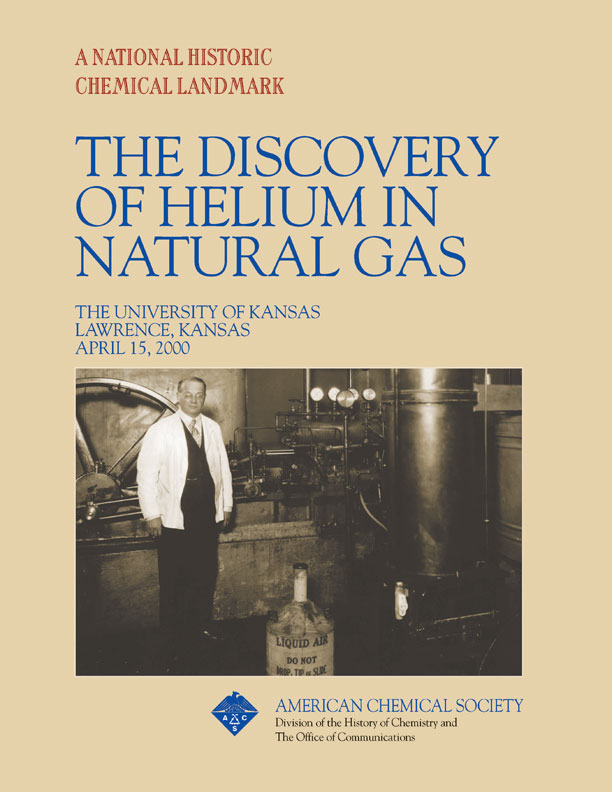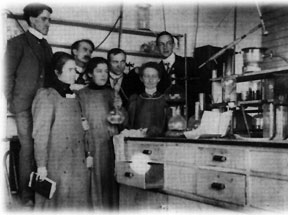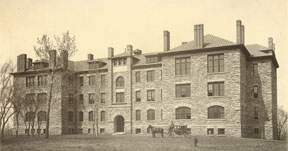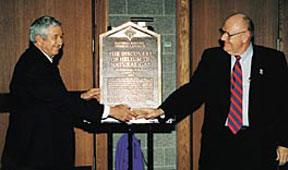Discovery of Helium in Natural Gas at the University of Kansas
Dedicated April 15, 2000, at The University of Kansas in Lawrence, Kansas.
Working in Bailey Hall on December 7, 1905, Hamilton P. Cady and David F. McFarland discovered significant amounts of helium in a natural gas sample from Dexter, Kansas. Cady and McFarland subsequently analyzed more than 40 other gas samples, showing that helium, previously thought to be rare on Earth but abundant in the Sun, was available in plentiful quantities from the Great Plains of the United States. Helium-filled blimps were vital to the United States in World War II, and helium is still considered a national strategic reserve material.
Contents
- Discovery of Helium, the Gas that Wouldn’t Burn
- Identification of Helium at the University of Kansas
- Helium Production and Uses
- Biorgraphy of Hamilton Perkins Cady
- Biography of David Ford McFarland
- Bailey Hall at The University of Kansas
- Further Reading
- Landmark Designation and Acknowledgments
- Cite this Page
Discovery of Helium, the Gas that Wouldn't Burn
Far from the great scientific centers of Europe, a jubilant crowd gathered in the small town of Dexter, Kansas, in May 1903. Situated in the vast Great Plains, Dexter was pinning its hopes for economic prosperity on a newly drilled well that had unleashed "a howling gasser." As nine million cubic feet of gas escaped each day before the equipment could be found to cap the well, the drilling company wasted no time in selling stock and planning for additional wells. The citizens of Dexter envisioned new industries such as ore smelters and brick and glass plants coming to their little town. To celebrate their good fortune, the people of Dexter planned a huge celebration, complete with band music, patriotic speeches, and games. The lighting of the escaping gas was planned as the spectacular climax to the day's events. Promotional circulars promised that "a great pillar of flame from the burning well will light the entire countryside for a day and a night."
After an appropriately exhilarating address by the mayor, the excited gathering watched with anticipation as a burning bale of hay was slowly moved into contact with the gusher. Instead of the expected conflagration, however, the flames of the burning bale were quickly extinguished.
Undaunted, the mayor repeated the process several times, but with the same results. Disappointed and puzzled, the crowd slowly dispersed, calling this strange emanation from the well "wind gas." Others said it was a well of "hot air." Understandably, the company "did not wish that it be given great publicity."
Dismay over the gas well's failure spread throughout Dexter, but Erasmus Haworth, the official state geologist, was intrigued by this unusual event. Haworth, a geology faculty member at The University of Kansas in Lawrence, arranged for a large steel cylinder to be filled with the Dexter gas. Upon his return to Lawrence, Haworth discussed the gas with chemistry professor David F. McFarland, who began a routine analysis of the cylinder's contents. The results readily gave a scientific explanation to the Dexter puzzle. The gas contained only 15% combustible methane, which would not burn in the presence of almost 72% nonflammable nitrogen. Haworth and McFarland reported their results to a Geological Society of America meeting in Philadelphia on Dec. 30, 1904. They revealed that the Dexter gas also contained 12% of an "inert residue" and promised that the investigation of this residue would "be carried out as soon as time would permit."
Identification of Helium at the University of Kansas
McFarland and chemistry department colleague Hamilton P. Cady began removing the nitrogen from the gas sample by applying a spark discharge with oxygen over an alkaline solution. Cady and McFarland found the procedure tedious and time consuming. "While it was going on," Cady said, "we decided to take advantage of [Sir James] Dewar's recently published discovery that coconut charcoal would adsorb all gases [in the atmosphere] except helium, hydrogen, and neon very completely at the temperature of boiling liquid air" (-310° F).
After making some coconut charcoal and building a glass apparatus to handle the gases, Cady and McFarland proceeded to immerse glass bulbs of the Dexter gas in liquid air and allowed them to stand for some time. This removed the hydrocarbons by condensation. The remaining gases were then transferred to glass bulbs containing coconut charcoal immersed in liquid air. The small amount of unabsorbed gas left after this treatment was passed into a glass tube and placed in a spectroscope. On Dec. 7, 1905, Cady and McFarland found that "instantly the yellow of the helium flashed up and the spectroscope showed all the lines of helium." The dominant spectroscopic line was identical to that found almost 40 years earlier in the spectroscopic analysis of the sun that led to the extraterrestrial discovery of helium. The total amount of helium present in the Dexter gas was an astonishing 1.84%.
Less than a month later, on January 1, 1906, E.H.S. Bailey, the chemistry department chair at Kansas, read a paper by Cady and McFarland describing their remarkable discovery before an ACS national meeting in New Orleans.
After perfecting a technique for the rapid determination of the amount of helium in natural gas and a method for separating the helium from the other gases, Cady and McFarland began to analyze a large number of gas wells in Kansas, Oklahoma, and Missouri. By the middle of 1906, they were able to report that they had "a very unusual opportunity for obtaining helium in practically unlimited quantities." When they published their complete findings in November 1907, Cady commented that their work "assures the fact that helium is no longer a rare element, but a common element, existing in goodly quantity for uses that are yet to be found for it."
Helium Production and Uses
Although helium was now potentially available in large quantities, it remained a laboratory curiosity for almost 10 years, and the entire American supply rested in three glass tubes, dusty and almost forgotten on the shelf in Bailey Hall at The University of Kansas. When Clifford W. Siebel came to Kansas to work on an advanced degree, Cady suggested that he should re-examine the helium content in natural gas for his thesis research. Siebel approached the problem reluctantly and without enthusiasm. When he read his results before a scientific audience in Kansas City in 1917, he concluded by expressing regret "that the work did not have a practical application." A representative from the U.S. Bureau of Mines "took immediate issue with that remark, and ... read a part of a letter from [Sir] William Ramsay in England in which the suggestion was made that the United States produce enough helium to inflate lighter-than-air craft for the Allies." The nonflammable and unreactive helium was desirable because it had almost the same lifting power as gaseous hydrogen, which is dangerous to handle because it is flammable.
Siebel was selling meager quantities of helium for $2,500 per cubic foot. He quickly calculated that at that rate, the cost of filling a small blimp was more than $100 million. Ten years later, after the U.S. government established plants at Fort Worth and Amarillo, Texas, the cost had dropped to three cents per cubic foot. Large-scale production of helium came too late to be of much value in World War I, but it did play a major role in World War II, when helium-filled U.S. Navy patrol blimps safely escorted thousands of ships carrying troops and supplies. The blimps used sensitive listening devices that when lowered into the water could detect submarines up to five miles away. At the time, the Allies had a virtual monopoly on helium, because the only known gas wells capable of producing helium in large quantities were in the United States and Canada.
Once helium became readily available in large quantities, other uses quickly followed. Today the U.S. Bureau of Land Management manages helium gas reserves, leasing, and storage. According to the bureau, "helium plays a prominent role in the Government's space, defense, and energy programs, such as pressurization of liquid propellants used by the space shuttle, weapons development, and nuclear fusion reactor experiments. Liquid helium uses include cooling infrared detectors, space simulations, materials testing, and biological and superconductivity research. Gaseous helium uses include various lighter-than-air activities, helium-neon lasers, detecting gas leaks, helium-oxygen mixture for deep sea diving, and high-speed welding of special metals." Helium has also been used for producing extremely high velocities in wind tunnels and in hospitals it serves as a cryogenic liquid for magnetic resonance imaging. It is still considered a strategic reserve material.
Biography of Hamilton Perkins Cady
Born in the little Kansas town of Skiddy, near Council Grove, Hamilton Perkins Cady (1874-1943) later moved with his family to Michigan, Tennessee, Ohio, and Wisconsin before returning to Kansas. Cady's interest in chemistry began one day in 1888 when a neighbor dissolved a silver spoon in nitric acid and, after adding salt to the solution, obtained a precipitate of silver chloride. That, said the neighbor, was chemistry. From that moment, young Cady knew that he wanted to be a chemist. Early in 1894, Cady entered The University of Kansas. He completed his undergraduate work in 1897 and for the next two years studied at Cornell. In 1899, he returned to Kansas as assistant professor of chemistry, receiving his Ph.D. in 1903.
Although Cady played a large role in isolating helium, he was perhaps better known to Kansans for his lectures on liquid air. Demonstrations of the liquid air plant, which had made the isolation of helium possible, became so popular on campus that scientists throughout the state clamored for a traveling version of the lecture. Cady rarely turned down a request for these "liquid air trips" — during 1916 and 1917 alone, he presented the lecture 37 times.
Cady became chair of the department upon E.H.S. Bailey's retirement in 1920 and retired from that position in 1940. His son George considered that Cady's "most important contribution to society was that of a teacher. Through his excellent lectures, fine demonstrations, keen wit, and sound philosophy, hammered home with a demand for high performance, he had a strong powerful influence on thousands of students."
Biography of David Ford McFarland
David Ford McFarland (1878-1955) was born in Ohio in 1878. He moved with his family to Lawrence, Kansas, where he attended public schools. In 1900, he received an A.B. degree in chemistry at The University of Kansas and immediately joined the chemistry department. During this period, he acquired an A.M. degree at Kansas in 1901, an M.S. degree at Yale in 1903, and a Ph.D. at Yale in 1909. He was also chemist and geologist with the University Geological Survey of Kansas from 1899 to 1908.
In 1910, McFarland moved to the University of Illinois, where he was assistant professor and associate professor of applied chemistry and a chemist and metallographist in the Engineering Experiment Station. While in Illinois, he focused his study on metallurgy and industrial chemistry. From 1920 until his retirement in 1945, McFarland was professor and head of the Department of Metallurgy at The Pennsylvania State University.
Bailey Hall at The University of Kansas
In 1887, the Kansas Legislature allocated funds for a new chemistry building at The University of Kansas. Edgar Henry Summerfield Bailey, the chemistry department chair, and architect J. G. Haskell toured schools on the East Coast to make sure the design included the most modern features. Although the new chemistry building was called "Bailey's Barn" almost from its dedication in 1900, it did not officially bear his name until 1938.
When it opened to students in the fall of 1900, the new chemistry building at Kansas was hailed as the most modern facility for chemistry west of Chicago. "The building is plain and massive in construction, and while very little was expended for adornment, no expense was spared to secure the best practical conditions for chemical and pharmaceutical work, according to modern methods," Bailey wrote.
In keeping with its commitment to excellence, the university's Board of Trustees agreed to a request by the chemistry department to purchase a liquid air plant that was installed in Bailey Hall in 1903. This acquisition enabled Cady and McFarland to make their initial discovery of helium in natural gas samples and to perfect their analysis and extraction techniques that would be critical to the large-scale helium production beginning at the end of World War I.
In 1956, Bailey Hall was renovated to become the School of Education. The distinctive chimneys were removed, a passenger elevator was added, and the laboratories, including the small basement laboratory where Cady and McFarland first isolated helium, were converted to classrooms and offices.
Landmark Designation and Acknowledgments
Landmark Designation
The American Chemical Society designated the discovery of helium in natural gas as a National Historic Chemical Landmark in a ceremony at The University of Kansas in Lawrence, Kansas, on April 15, 2000. The plaque commemorating the event reads:
Working in Bailey Hall on December 7, 1905, Hamilton P. Cady and David F. McFarland discovered significant amounts of helium in a natural gas sample from Dexter, Kansas. Cady and McFarland subsequently analyzed more than 40 other gas samples, showing that helium, previously thought to be rare on Earth but abundant in the Sun, was available in plentiful quantities from the Great Plains of the United States. Helium-filled blimps were vital to the United States in World War II, and helium is still considered a national strategic reserve material. Today, helium is used in airships and balloons, low-temperature research, arc welding, lasers, nuclear reactors, and magnetic resonance imaging.
Acknowledgments
Adapted for the internet from “The Discovery of Helium in Natural Gas,” produced by the National Historic Chemical Landmarks program of the American Chemical Society in 2000.
Learn more: About the Landmarks Program
Take action: Nominate a Landmark and Contact the NHCL Coordinator








